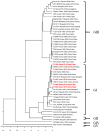Genotype Change in Circulating JEV Strains in Fujian Province, China
- PMID: 37766229
- PMCID: PMC10536422
- DOI: 10.3390/v15091822
Genotype Change in Circulating JEV Strains in Fujian Province, China
Abstract
Japanese encephalitis (JE), found in pigs, is a serious mosquito-borne zoonotic infectious disease caused by the Japanese encephalitis virus (JEV). JEV is maintained in an enzootic cycle between mosquitoes and amplifying vertebrate hosts, mainly pigs and wading birds. It is transmitted to humans through the bite of an infected mosquito, allowing the pathogen to spread and cause disease epidemics. However, there is little research on JEV genotype variation in mosquitoes and pigs in Fujian province. Previous studies have shown that the main epidemic strain of JEV in Fujian Province is genotype III. In this study, a survey of mosquito species diversity in pig farms and molecular evolutionary analyses of JEV were conducted in Fujian, China, in the summer of 2019. A total of 19,177 mosquitoes were collected at four sites by UV trap. Four genera were identified, of which the Culex tritaeniorhynchus was the most common mosquito species, accounting for 76.4% of the total (14,651/19,177). Anopheles sinensi (19.25%, 3691/19,177) was the second largest species. High mosquito infection rateswere an important factor in the outbreak. The captured mosquito samples were milled and screened with JEV-specific primers. Five viruses were isolated, FJ1901, FJ1902, FJ1903, FJ1904, and FJ1905. Genetic affinity was determined by analyzing the envelope (E) gene variants. The results showed that they are JEV gene type I and most closely related to the strains SH-53 and SD0810. In this study, it was found through genetic evolution analysis that the main epidemic strain of JE in pig farms changed from gene type III to gene type I. Compared with the SH-53 and SD0810 strains, we found no change in key sites related to antigenic activity and neurovirulence of JEV in Fujian JEV and pig mosquito strains, respectively. The results of the study provide basic data for analyzing the genotypic shift of JEV in Fujian Province and support the prevention and control of JEV.
Keywords: Fujian; JEV; mosquito.
Conflict of interest statement
The authors declare no conflict of interest.
Figures

Similar articles
-
Vector Mosquito Ecology and Japanese Encephalitis Virus Genotype III Strain Detection from Culex tritaeniorhynchus and Pig in Huaihua, China.Vector Borne Zoonotic Dis. 2019 Dec;19(12):933-944. doi: 10.1089/vbz.2019.2453. Epub 2019 Jun 10. Vector Borne Zoonotic Dis. 2019. PMID: 31184992
-
Molecular epidemiology of Japanese encephalitis virus in mosquitoes in Taiwan during 2005-2012.PLoS Negl Trop Dis. 2014 Oct 2;8(10):e3122. doi: 10.1371/journal.pntd.0003122. eCollection 2014 Oct. PLoS Negl Trop Dis. 2014. PMID: 25275652 Free PMC article.
-
Molecular epidemiology of mosquito-borne viruses at the China-Myanmar border: discovery of a potential epidemic focus of Japanese encephalitis.Infect Dis Poverty. 2021 Apr 26;10(1):57. doi: 10.1186/s40249-021-00838-z. Infect Dis Poverty. 2021. PMID: 33902684 Free PMC article.
-
Review of climate, landscape, and viral genetics as drivers of the Japanese encephalitis virus ecology.PLoS Negl Trop Dis. 2013 Sep 12;7(9):e2208. doi: 10.1371/journal.pntd.0002208. eCollection 2013. PLoS Negl Trop Dis. 2013. PMID: 24069463 Free PMC article. Review.
-
The Ecology and Evolution of Japanese Encephalitis Virus.Pathogens. 2021 Nov 24;10(12):1534. doi: 10.3390/pathogens10121534. Pathogens. 2021. PMID: 34959489 Free PMC article. Review.
Cited by
-
Sheep serve as amplifying hosts of Japanese encephalitis virus, increasing the risk of human infection.Sci Adv. 2025 May 16;11(20):eads7441. doi: 10.1126/sciadv.ads7441. Epub 2025 May 16. Sci Adv. 2025. PMID: 40378218 Free PMC article.
-
Distribution and frequency of genetic mutations in three insecticide targets in field populations of Culex tritaeniorhynchus in Mianyang City, Sichuan Province, China.Front Cell Infect Microbiol. 2025 Feb 6;15:1496849. doi: 10.3389/fcimb.2025.1496849. eCollection 2025. Front Cell Infect Microbiol. 2025. PMID: 39981375 Free PMC article.
-
Survey of mosquito species in intensive pig farms in Hunan province, China.Trop Anim Health Prod. 2024 Aug 3;56(7):233. doi: 10.1007/s11250-024-04076-x. Trop Anim Health Prod. 2024. PMID: 39096351
-
Genetic Characterization of Japanese Encephalitis Virus Isolates Circulating in Mosquitoes from Pig and Sheep Farms in Shanghai, China.Animals (Basel). 2024 Dec 18;14(24):3653. doi: 10.3390/ani14243653. Animals (Basel). 2024. PMID: 39765557 Free PMC article.
References
Grants and funding
- No. 2022YFD1800502/National Key Research and Development Program of China
- (No. X2021-02-08-00-12-F00770/Shanghai Agriculture Applied Technology Development Pro-gram, China
- (No. ZD2021CY001/Shanghai Municipal Science and Technology Major Project
- No. 22N41900400/Project of Shanghai Science and Technology Commission
- No. 125161035/Asian Regional Cooperation Fund
LinkOut - more resources
Full Text Sources

